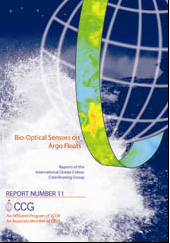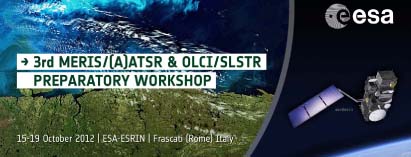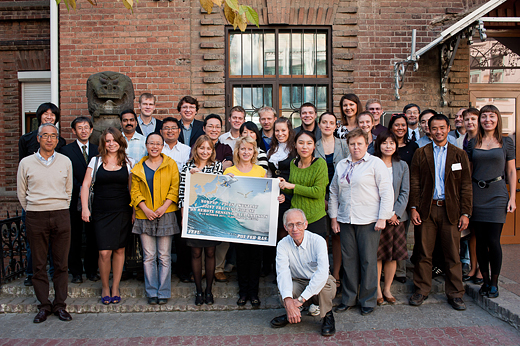

|
|
The IOCCG Chairman and the IOCCG Committee extend their best wishes to the ocean-colour community over the festive season. 
The IOCCG will be conducting an advanced Summer Lecture Series dedicated to high-level training in the fundamentals of ocean optics, bio-optics and ocean colour remote sensing. The course will take place at the Laboratoire d'Océanographie de Villefranche (LOV) in Villefranche-sur-Mer, France from 2 – 14 July 2012 (see www.obs-vlfr.fr/LOV/OMT/). A number of distinguished scientists have been invited to provide lectures on cutting edge research, focussing on current critical issues in ocean colour science. Students will be given ample opportunity to meet with the lecturers for in-depth discussions on various topics, including their own scientific research. The lecture series is open to young graduate scientists and post-doctoral fellows involved in any aspect of ocean-colour research. Students currently undertaking their PhD studies, as well as researchers with a longer record in ocean colour research hoping to broaden their knowledge, are also invited to apply. For further information on the course and how to apply, please see the announcement on the IOCCG website: www.ioccg.org/training/upcoming.html. The deadline for applications is 16 March 2012.
 
The working group on Bio-optical Sensors on Argo Floats, chaired by Hervé Claustre (LOV, France), was established by the IOCCG to evaluate the feasibility of equipping Argo floats with bio-optical sensors. Bio-optical sensors on Argo floats are able to provide information about the deeper ocean layers not attainable by satellite platforms, and they can also obtain measurements of near-surface properties under conditions of cloud cover. Furthermore, these measurements can be used to validate and refine ocean colour algorithms.
The working group recommended that Chl-a and POC should be the key variables to be measured systematically. They also recommended the development of three main types of bio-optical floats: (i) the BIO-Argo float, to provide vertical profiles of key biogeochemical and bio-optical variables (e.g. Chl-a fluorescence, backscattering coefficient); (ii) the Carbon-float to optically monitor POC and PIC, dedicated to process studies aimed at investigating key stocks and fluxes involved in the carbon cycle, and (iii) the Val-float to measure downwelling irradiance (Ed) and upwelling radiance (Lu) associated with Chl-a fluorescence and backscattering coefficients, for validation of ocean colour algorithms.
The report from this working group has been finalised (IOCCG Report 11) and will be printed by the Joint Research Centre (Italy) within the next few months, which is gratefully acknowledged. Copies will be sent via surface mail to all subscribers on the IOCCG mailing list once printing is completed, so please allow several months for delivery. In the meantime a low resolution PDF file of the report can be downloaded from the IOCCG website at:

A working group on Ocean Colour Remote Sensing in Polar Seas, co-chaired by Marcel Babin (Université Laval, Canada), Kevin Arrigo (Stanford University, USA) and Simon Bélanger (Université du Québec à Rimouski, Canada) was recently established by the IOCCG. The working group was formed to increase our understanding of polar ecosystems in light of the ongoing changes in the Arctic as a result of climate change, e.g. in Arctic waters summer ice cover has receded by ~30% over the last 3 decades and primary production and the photooxidation of coloured dissolved organic matter is increasing. Ocean colour remote sensing can be used to monitor Arctic and Antarctic ecosystems on synoptic scales although there are a number of inherent difficulties and limitations, which were the focus of the first meeting of the Polar Seas working group. The meeting took place in Québec City, Canada from 10-11 November 2011, where working group members gave presentations on different aspects of remote sensing in polar seas, followed by informative discussion sessions. The group agreed to hold monthly teleconferences of the various subgroups. A general outline of a proposed IOCCG report on the topic was prepared at the meeting. Further information can be found in the minutes of the meeting.

At the meeting, the structure of an IOCCG monograph on this topic was discussed including the breakdown of the various chapters and case studies. Special emphasis was placed on applications, techniques and challenges of remote sensing in inland waters, specifically ocean colour algorithms for detection of cyanobacterial blooms. A full report of the meeting plus an outline of the proposed IOCCG report will be available on the working group website shortly.

The 2nd GOCI PI workshop and the 1st GOCI-II Development Workshop will be held in Ansan, Korea on 11-13 January 2012. GOCI is the first ocean colour satellite in a geostationary orbit dedicated to the observation of the NE Asian region (see Yangtze discharge captured by GOCI). It will contribute significantly to the nation's efforts to effectively monitor, predict and respond to changes in the ocean environment as a result of natural or man-made disasters. GOCI-II will have better spatial resolution and spectral performance and will expand the mission of GOCI. The development of GOCI-II will start in 2012 aiming for its launch in 2018. Abstracts are being solicited in the following areas: GOCI (instrument, cal/val, applications); GOCI-II (design, user requirements); science from current OC sensors; future OC missions. The workshop will be preceded by the Japan-Korea Workshop on Ocean Color Remote Sensing (JKWOC) on 10 January 2012 - this workshop is held every year to discuss research results around Korea and Japan using ocean observation network such as satellites, buoys and airborne data. For further information on these workshops please consult the Korea Ocean Satellite Center (KOSC) website as well as the announcement poster.

The SCOR-sponsored book, "Phytoplankton Pigments", was published in October 2011 by Cambridge University Press. The book provides new information since the highly successful 1997 book from SCOR WG 78 entitled Phytoplankton Pigments in Oceanography. The previous book has been cited more than 400 times and is still used in many laboratories worldwide. "Phytoplankton Pigments" will be sent by SCOR to libraries in developing countries and a limited number of copies will be available from the SCOR Secretariat. Additional copies can be purchased from Cambridge University Press. Additional resources such as data sheets and appendices from the book are also available free of charge from Cambridge University Press at this site.
 You are invited to the 2012 EUMETSAT Meteorological Satellite Conference. The Conference will take place 3-7 September, 2012, in the Polish seaside town of Sopot. Satellite observations of the oceans, including the Sentinel-3 mission, is one of the main themes of the EUMETSAT 2012 conference. Sentinel-3 with its OLCI ocean colour instrument is an element of the Global Monitoring for Environment and Security (GMES) programme led by the European Commission in partnership with the European Space Agency. EUMETSAT will operate Sentinel-3 and host the marine core ground segment. EUMETSAT will also serve the marine user community with near-real time and off-line products. The efforts are on-going to institute the ground segment, define calibration and validation approaches, and to build the ocean colour service. EUMETSAT is thus looking for statements of interest from the user community and for feedback directed towards mission planning. The conference will offer an excellent opportunity to highlight ocean colour applications, lessons learned, and to convey user requests and recommendations. For further information please see the EUMETSAT conference announcement. The deadline for abstract submission is 23 January 2012! |
NASA’s NPP satellite (National Polar-orbiting Operational Environmental Satellite System Preparatory Project) was successfully launched on 28 October 2011. The NPP satellite is the precursor to the next generation of operational polar-orbiting satellites, the Joint Polar Satellite System (JPSS), and carries a total of five instruments, including the Visible/Infrared Imager Radiometer Suite (VIIRS) which will provide measurements of ocean biological productivity and other critical data to support long-term climate research. Less than a month after launch, the VIIRS instrument collected its first image (on 21 Nov 2011) capturing a broad swath of the US east coast (see NASA announcement). The first complete, but preliminary, global view of ocean Chl-a concentrations (below), derived from the first day and a half of VIIRS data, was obtained on 21-22 November 2011, derived from the NASA-processed Level-2 evaluation data products processed by the NASA Ocean Biology Processing Group.
NPP will undergo a series of tests for approximately 9-15 months before it is turned over to NOAA for operations. During NPP's five-year life, the mission will extend more than 30 key long-term datasets that include measurements of the atmosphere, land and oceans.

 The NASA Giovanni data system, hosted at the Goddard Earth Sciences Data and Information Services Center (GES DISC), provides a wide variety of mapped Earth science data parameters from NASA missions and projects for the scientific community. For the past few years, the only ocean colour radiometry (OCR) data sets in Giovanni have been monthly averages, which do not always capture the remarkably varying patterns in the global oceans. Now, as part of the Water Quality for Coastal and Inland Waters Project (Zhongping Lee, PI; James Acker, et al.), OCR data at 8-day resolution is available in Giovanni. These data are available at 4-km and 9-km spatial resolution for MODIS, and at 9-km resolution for SeaWiFS. Together, these datasets comprise a 13-year observational period, beginning in September 1997 for SeaWiFS. In addition to the standard NASA data products, Giovanni is providing, for the first time, evaluation data products which include absorption coefficients and backscattering coefficients, also at 8-day resolution. Such data can yield remarkable insight into the timing of ocean optical events related to storms and floods and their effect on the coastal zone, as well as a better characterization of the growth and senescence phases of phytoplankton blooms. Follow the link to the full illustrated article, which also provides a direct link to the Giovanni 8-day ocean colour data portal.

The European Space Agency (ESA) is organising the Third MERIS-AATSR and Sentinel-3 preparatory workshop, which will be hosted in ESA-ESRIN, Frascati, Italy, from 15 to 19 October 2012. The workshop is open to scientists and students using MERIS/AATSR data, including ESA PIs and co-investigators, future follow-on Sentinel-3 data users, and representatives from space agencies and value adding industries. The goal of the workshop is to provide a forum for ESA PIs and scientists to present new results, update users on instrument performance and product quality, gather the future Sentinel-3 R&D user community, present Sentinel-3 mission algorithms and products, discuss the transition from ENVISAT (MERIS/(A)ATSR) to Sentinel-3 (OLCI/SLSTR) and foster the synergy between the MERIS & (A)ATSR and the OLCI & SLSTR instruments. Abstract Submission opens on 1 March 2012. For further information see the announcement.

A Sentinel-3 Calibration and Validation Planning Meeting will take place at ESA/ESRIN from 20-22nd March 2012, to present an overview and status of Sentinel-3 cal/val activities, review the Draft Sentinel-3 cal/val plan, seek lessons learned feedback and inputs from previous missions and the cal/val community and, provide Sentinel-3 teams with prioritized recommendations to ensure an effective and successful mission cal/val outcome. The Global Monitoring for Environment and Securing (GMES) Sentinel-3 satellite is now being manufactured and expected to launch in late 2013. The Satellite carries follow-on instruments to the highly successful ENVISAT platform including the Ocean and Land Colour Imager (OLCI) providing continuity to ENVISAT MERIS spectrometer measurements. After launch, a 5-month Mission Commissioning Phase (E1) followed by a Long term Operational Mission Phase (E2) will be initiated. During E1 intensive activities will establish the functionality and initial performance of the Sentinel-3 system based on calibration and validation activities. Following a successful commissioning review, the satellite will then continue in nominal operations for Phase E2 supported by on-going calibration and validation activities to monitor and maintain data quality. For further information on the meeting please click here.
 The NOWPAP/PICES/WESTPAC joint training course on remote sensing data analysis was organized by the NOWPAP Special Monitoring & Coastal Environmental Assessment Regional Activity Centre (CEARAC), the North Pacific Marine Science Organization (PICES) and IOC Sub-Commission for the Western Pacific (WESTPAC) at the Far Eastern Federal University (FEFU) in Vladivostok, Russia on 8-12 October 2011. The course was co-sponsored by the IOCCG.  The training course was conducted for 22 selected trainees including postgraduate students, professional researchers and local government officers working in the field of marine sciences, from China, Japan, Korea, Russia, India, Indonesia and the Philippines. Ten lecturers, including IOCCG members Yu-Hwan Ahn, Roland Doerffer and Joji Ishizaka, delivered lectures on remote sensing applications for monitoring and assessment of the marine and coastal environment in the Northwest Pacific Region. The students obtained useful skills and knowledge to utilize remote sensing data for monitoring and assessing coastal and open ocean environments. The full report of the training course is available on the NOWPAP CEARAC website.

Several new references have been added to the IOCCG Recent References list, including a paper by Griet Neukermans et al. (2012) which analyzes the link between scattering properties and dry mass concentration of suspended particles based on an extensive in situ dataset from coastal and offshore waters. The variability in mass-normalized particulate attenuation and backscattering coefficients at a wavelength of 650 nm is investigated with respect to bulk particle size, apparent density, and composition, for the first time. It is shown that the mass-specific particulate attenuation coefficient varies over one order of magnitude and is strongly driven by particle apparent density, while the mass-specific particulate backscattering coefficient is relatively well constrained and is well correlated with particle composition. Overall, this study offers new insight into the sources of optical variability in natural waters and contributes to the in situ monitoring of suspended particles and the development of remote sensing algorithms for suspended particulate matter concentration. Another new publication by Bulgarelli and Djavidnia (2011, Geoscience and Remote Sensing Letters, IEEE) shows the potential of MODIS as a cost-effective supplementary tool for oil spill monitoring in the marine environment. The mechanism behind MODIS oil feature detection, as well as the type of information that might be retrieved, depends on the illumination conditions. In the presence of sunglint contamination, MODIS can locate the oil spill as a sea surface roughness anomaly, similar to radar observations, and no additional spectral information can be retrieved. MODIS detection in the absence of sunglint contamination, however, might allow extraction of oil feature spectral properties, which, in turn, may help in oil discrimination and classification. Careful atmospheric correction must be applied. An example of oil spill spectral property extraction from MODIS images is shown for the Deepwater Horizon accidental oil spill.
 Several new positions have been added to the Employment Opportunities section of the IOCCG website, including Post-doctoral and Research Scientist positions at various locations around the world including USA, Italy, Sweden, China, Singapore and Hawaii.
|
|
Material for possible inclusion in the IOCCG Newsletter should be submitted to the Project Scientist, Dr. Venetia Stuart
Subscription to the IOCCG Mailing List. Participants receive a brief summary of the IOCCG Newsletter by e-mail (quarterly), as well as hard copies of IOCCG Reports as, and when, they become available.
|
|
|
|